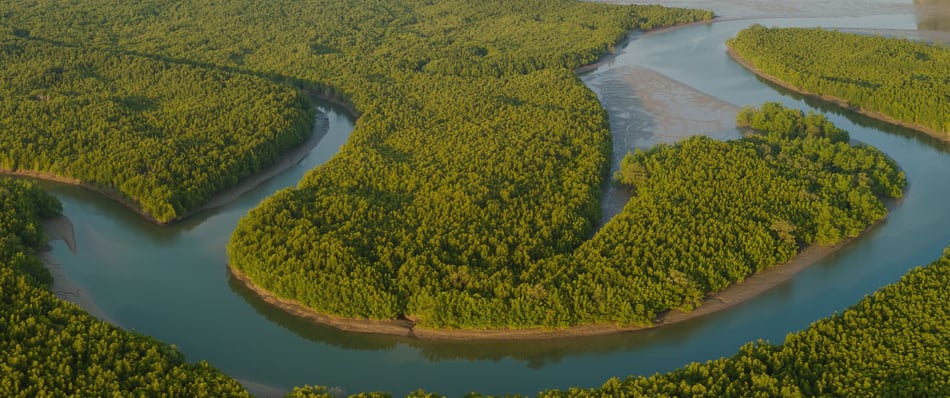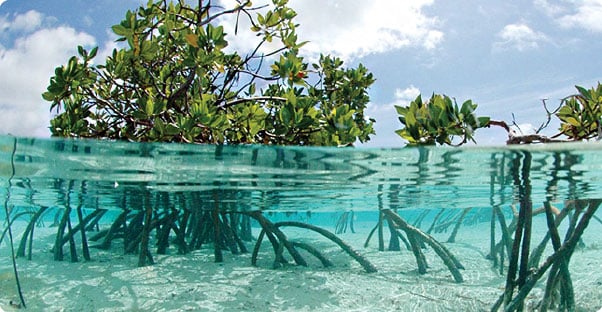Why blue carbon is more valuable than other nature-based climate solutions

Jordan
3
min. read

Blue carbon has a significant effect on our daily lives - and the entire planet - as it is the largest carbon reservoir stored within the largest system of water on Earth. While it's becoming more familiar in popular parlance, it is still far from a commonly discussed topic - but whether or not you've heard this term before, you probably know more about it than you realize.
What is blue carbon?
Blue carbon is simply the term for carbon captured by and stored within ocean ecosystems, including reefs, tidal areas, and even coastal wetlands. Mangroves are particularly good at taking in and permanently storing carbon in their roots, along with sea grasses and salt marshes that also do a good job of storing CO2 dissolved in ocean water. There is also potential to store carbon in calcifying organisms such as coral - or, as the IMARCS Foundation is pioneering, in giant clams.
These coastal systems, including reefs, are significantly smaller in size than the planet's forests, sequester this carbon at a much faster rate, and can continue to do so for millions of years. These areas naturally sequester CO2 and have done so long before people began emitting GHGs or realized that it would be a good idea to limit the rate of atmospheric carbon accumulation. However, in keeping with human ingenuity, we have looked at the natural storage abilities of the ocean and developed enhanced nature-based solutions to maximize sequestration benefits.
These coastal systems, including reefs, are significantly smaller in size than the planet's forests, sequester this carbon at a much faster rate, and can continue to do so for millions of years. These areas naturally sequester CO2 and have done so long before people began emitting GHGs or realized that it would be a good idea to limit the rate of atmospheric carbon accumulation. However, in keeping with human ingenuity, we have looked at the natural storage abilities of the ocean and developed enhanced nature-based solutions to maximize sequestration benefits.

Image Credits - https://blog.wcs.org/photo/2021/12/02/what-is-blue-carbon-and-why-is-it-important/
What makes blue carbon valuable?
Blue carbon is valuable for several reasons, though the two most important ones are surely: 1) It is the most available and most permanent form of carbon storage, and 2) it creates immensely beneficial environmental impacts in addition to carbon storage, including coastal habitat conservation, nurseries for reef species, protection from offshore storms, erosion prevention, and more.
Why is the future of blue carbon more promising than REDD+ or other nature-based climate solutions?
When blue carbon is quantified and incorporated into the international carbon market, it is more valuable than emission avoidance and other nature-based solutions (NBS) that generate carbon offset credits. through the buying and selling of carbon offsets. This is due mainly to sequestration and permanence: blue carbon is a form of CDR, where CO2 is directly removed from the atmosphere and stored for thousands of years. When compared with avoidance credits, such as renewable energy credits (RECs), which offset carbon emitted by generating CO2-free energy in place of fossil fuel combustion, blue carbon actually reduces carbon that has already been released into the air. When it comes to other NBS projects, such as REDD+ (reducing emissions from deforestation and degradation), blue carbon is again more valuable because of CO2 removal permanence - carbon stored in tropical rainforests can be released through leakage, including uncontrolled fires or even harmful natural storm events. While all NBS projects create a financial incentive for restoration and conservation - making them all extremely valuable as a holistic part of sustainability - blue carbon is the best route when specifically targeting carbon sequestration.
It is clear that carbon offsets will be a necessary part of any company's path to net-zero emissions if they want to achieve this by 2030 - and likely still by 2050. There are just not that many current pathways for decarbonization in any meaningful way for most companies, and for some, due to the nature of their operations, it is literally not possible to get anywhere near net-zero without offsets.
Quantifying blue carbon and assigning a value to it - in the process incentivizing its capture and storage - should help slow atmospheric CO2 accumulation alongside other developing solutions, and is directly in line with a more holistic approach to sustainability. Carbon offset credits are incredibly important and valuable, more so than most people think. Not only do they keep ecosystems intact, when generated properly, they provide biodiversity preservation, improve soil conservation, stop habitat fragmentation, and employ local community members who deserve to benefit from the natural riches contained along their coastlines.
In the near future, the IMARCS Foundation hopes to add a novel, multi-faceted blue carbon approach through giant clam mariculture. As of the time of writing, we are in the process of evaluating the carbon-negative potential of growing out clams, utilizing on-shore tanks with altered water parameters to test CO2 storage capabilities. We will be updating and publishing this research as it becomes available. If you would like to learn more, please reach out to us at:
president@imarcs.org
relationships@imarcs.org
jordan@imarcs.org
It is clear that carbon offsets will be a necessary part of any company's path to net-zero emissions if they want to achieve this by 2030 - and likely still by 2050. There are just not that many current pathways for decarbonization in any meaningful way for most companies, and for some, due to the nature of their operations, it is literally not possible to get anywhere near net-zero without offsets.
Quantifying blue carbon and assigning a value to it - in the process incentivizing its capture and storage - should help slow atmospheric CO2 accumulation alongside other developing solutions, and is directly in line with a more holistic approach to sustainability. Carbon offset credits are incredibly important and valuable, more so than most people think. Not only do they keep ecosystems intact, when generated properly, they provide biodiversity preservation, improve soil conservation, stop habitat fragmentation, and employ local community members who deserve to benefit from the natural riches contained along their coastlines.
In the near future, the IMARCS Foundation hopes to add a novel, multi-faceted blue carbon approach through giant clam mariculture. As of the time of writing, we are in the process of evaluating the carbon-negative potential of growing out clams, utilizing on-shore tanks with altered water parameters to test CO2 storage capabilities. We will be updating and publishing this research as it becomes available. If you would like to learn more, please reach out to us at:
president@imarcs.org
relationships@imarcs.org
jordan@imarcs.org

Image Credits - https://www.unep.org/news-and-stories/story/surfers-ride-wave-ocean-action-myanmar-blue-forest